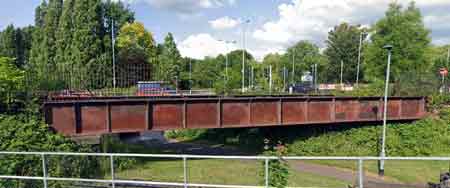Taylor Ln, Denton
This farm was situated on the north-east side of Taylor Ln about 435 yards distant from Manchester Rd. It took its name from the Moss family who were farming on Taylor Ln by 1841.
The 1841 census shows that Thomas Moss (1807-1864) was the farmer with his wife, Ann Keaton, and family. In 1851 he was farming 126 acres, employing five labourers.
In 1861 he was farming 72 acres, employing five men and one boy, with the assistance of his son, Peter, and daughter, Ann. He died in 1864, aged 56 years, but it seems that none of his family succeeded him at the farm.
By 1871 Peter Moss was a hat blocker in the hatting industry and the occupier of Moss Farm is unclear. In 1881 Jonathan Hyde was the occupier of the farm and he was still there when he died in 1899, aged 60 years.
The 1911 census shows that Wilfred Lawson Cooper (1870-1950) was then the occupier of the farm.
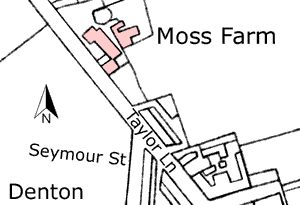
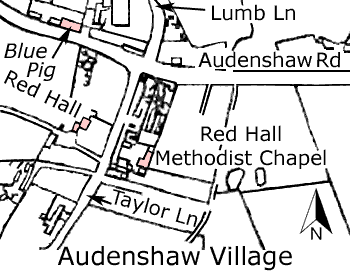
Left: Map of Taylor Ln, Denton, showing Moss Farm.
Right: Map of Taylor Ln, Audenshaw Village, showing the end of the lane prior to the construction of Audenshaw Reservoirs.
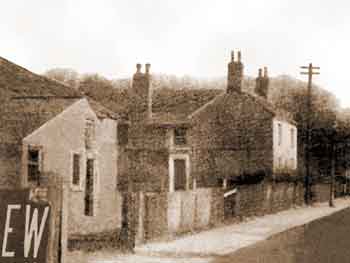
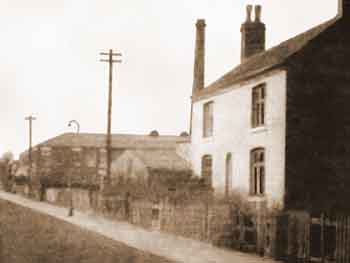
Left: View of the farm looking up Taylor Ln towards Manchester Rd.
'EW' painted on the wall on the left stands for 'Emergency Water Supply'. The sign was painted by the Air Raid Precautions (ARP) during World War II.
Right: View of the farm looking down Taylor Ln towards Wellington Works.
Taylor Ln, Denton/Audenshaw and Audenshaw Reservoirs
Following construction of Audenshaw Reservoirs, Taylor Ln ended abruptly at the railway line.
Prior to this it crossed over the railway on a brick bridge and continued through the fields into Audenshaw, via the hamlet of Corn Hill,
and on to Audenshaw Village where it passed between Red Hall to the west and Red Hall Methodist Chapel to the east. The lane then joined Audenshaw Rd opposite Lumb Ln and near the Blue Pig.
Audenshaw Village was demolished when the reservoirs were built.
The three Audenshaw Reservoirs were constructed for Manchester Corporation Waterworks between 1877 and 1882, the work being supervised by the civil engineer, John Frederick La Trobe Bateman FRSE FRS MICE FGS FSA.
The greatest waterworks project undertaken by John Frederick La Trobe Bateman was the supply of water to the Manchester area from reservoirs in the Pennine hills near Glossop. He was first consulted about this project in 1844 and by 1846 he had developed a proposal to obtain water from a chain of reservoirs to be known as Longdendale Reservoirs. Work commenced in 1848 and was completed in Spring 1877.
A blue plaque commemorating John Frederick La Trobe Bateman was fixed on a ventilation shaft for a water tunnel (Mottram Tunnel) that carries water to the Tameside and Manchester areas. This shaft is situated at Mottram in Longdendale and it was unveiled by Councillor Roy Oldham of Tameside on the 15 Sep 2000.
However, the supply of water from these reservoirs was insufficient for the area and further sources of water had to be found. He recommended that Manchester Corporation Waterworks should obtain water from Thirlmere in the Lake District. Consequently, a bill was introduced into Parliament in 1878 which was rejected but passed the following year. He superintended their construction assisted by George Hill.
The works required the construction of the 96-mile long Thirlmere Aqueduct, between Thirlmere and Heaton Park Reservoir in Prestwich, and water arrived in the Manchester area from the Lake District to be acclaimed by an official ceremony on 13 Oct 1894. This was the completion of the first phase and construction continued until 1925. A branch of Thirlmere Aqueduct runs along the north side of Manchester Rd as far as Denton Reservoirs where it turns north to enter Audenshaw Reservoir No. 2 via a valve in the inlet weir.
